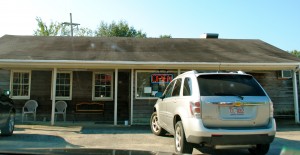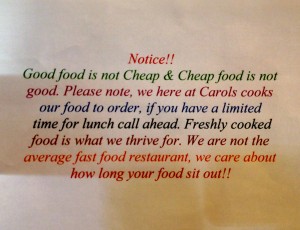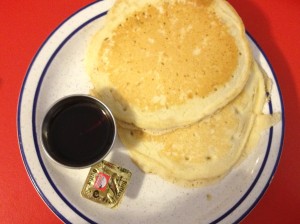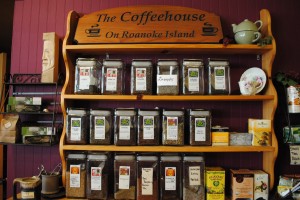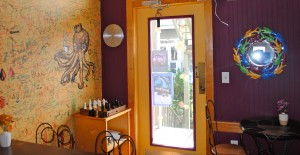By: Phoebe Hyde
The joys of traveling down an unfamiliar road through an unknown town are realized at times
like this. Our morning started early, being awoken by a mix of our nerves from our night’s stay
in the Williamston motel and our excitement over that day’s itinerary. Carol’s Home Cooking,
although not on our itinerary, was the ideal place to stop to suppress our grumbling stomachs,
even though we’d been driving for only about 25 minutes. It is places like this that inspired
our original motivation to create a lenient itinerary. It was essential to leave ample time for
potentially undiscovered or unwritten about establishments that we knew would tempt our
attendance, and Carol’s Home Cooking was just that.
This one-story, washed-grey shingled building appearing originally to be a home to a small
family had a neon OPEN sign on the front window and a sign out front reading “Carol’s Home
Cooking*Eat in or Take Out.” After nearly passing the restaurant since our eyes couldn’t read
fast enough, our car screeched as we pressed down on the break pedal making sure not to
miss the parking entrance. We hesitated at the sight of the white van out front with capital red
letters that read Pit Cooked Barbeque, thinking, maybe they are not serving breakfast at nine
o’clock in the morning if they are, in fact, a barbecue restaurant, but the OPEN sign gave us
hope. We also promised each other that, despite our breakfast food craving, we would eat
barbeque for breakfast just this once, because we could not pass up a place like this. Clearly, if
this remotely located restaurant was still standing in the middle of the miles of straight, single-
lane highway roads and cotton fields that led us into Robersonville, there must be something
remarkable inside. The aromatic smells of hot-off-the-griddle cooking that filled our nostrils the
moment we stepped inside only solidified that assumption, and our bellies grumbled again.
We were greeted at the door by a soft-spoken woman with a generous smile on her face. She
brought us over to a red circular table on the far side of the square shaped room, placed the
menu in front of each of us—an eight by eleven piece of paper, which listed the breakfast items
each in a different pastel color—and took our drink orders. Taking a look around before deciding
what to order, my eyes were drawn to the framed piece of paper which stated (in rainbow
italicized font)
“Notice!! Good food is not Cheap & Cheap food is not good. Please note, we here at
Carols cooks our food to order, if you have a limited time for lunch call ahead. Freshly
cooked food is what we thrive for. We are not the average fast food restaurant, we care
about how long your food sit out!!”
The sign brought a gentle smile to my face and I turned back to the menu in front of me.
Brittany ordered first, kindly stating, “Can I have Herring?” The woman responded, “She doesn’t
have any of those today.” This response caught my attention, as it is not everyday that I hear
one refer solely to the chef rather than to the restaurant as a whole. This again alluded to the
uniqueness and authenticity of this restaurant, and the important role that Carol holds in the
establishment. I then ordered a pancake, which was listed on the menu as “Pancake ($2).”
Watching my budget, I was pleased with this price list, and also assumed I would be getting one
pancake for two dollars, which seemed more than reasonably priced to me. But I was wrong.
Moments later, but enough time to have whipped up the batter and poured the freshly made
batter on the griddle, my two pancakes were served to me with a side of maple syrup poured in
a small, silver metal cup along with a small container of gold packaged butter. The smell was
overwhelming, while the heat lifted off the pancakes and warmed my cheeks. I took a bite. I
hesitate to say they were better than my mom’s homemade pancakes, but there is undoubtedly
some serious competition (I hope she doesn’t read this). The lightly crisped, soft brown edges
perfectly complemented the fluffy, moist inside that melted on my tongue with each bite. I
tried to pace myself but kept wanting more, and was immediately grateful that I was given two
pancakes!
Sad to see my two pancakes disappear, we packed up our things and walked up to the front to
pay our bill. I took out a five-dollar bill, in anticipation of getting one dollar back to leave on the
table as a tip. I saw a green neon $2.00 show up on the cash register, and waited a moment for
the number to increase. “Two dollars,” our waitress said to me. Shocked, I happily handed her
my five-dollar bill and received far more change than I initially expected.
Carols Home Cooking is a diamond in the ruff. Directly off the un-trafficked Highway 64,
on the left hand side if headed west, Carol’s Home Cooking is located amongst the large
expanse of cotton fields. It is no surprise that people travel all the way from Rockymount
(nearly forty minutes away) just to eat here. Carol’s Home Cooking far surpassed my already
high expectations of the restaurant on all accounts—in taste, cleanliness, friendliness of staff,
service, & pricing. It is places like Carol’s that one learns to appreciate randomness and happen
stance, and places like this that quantify the value of field study opposed to that done by mere
internet research.

